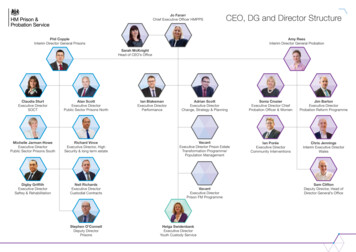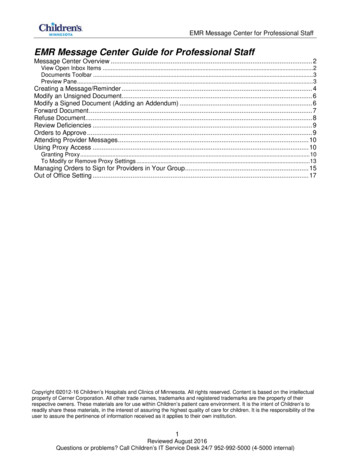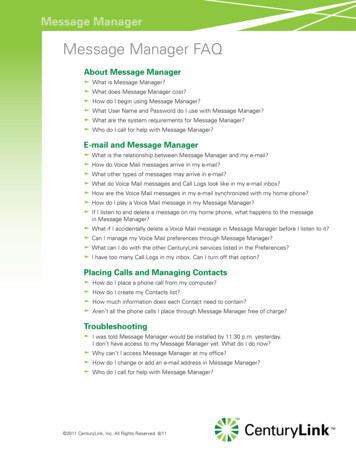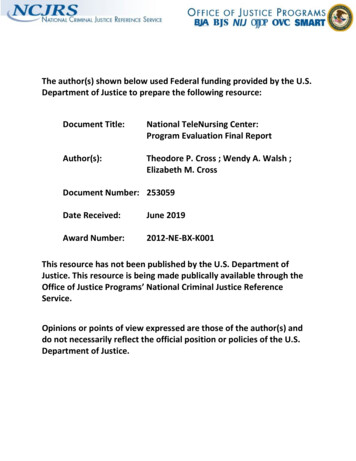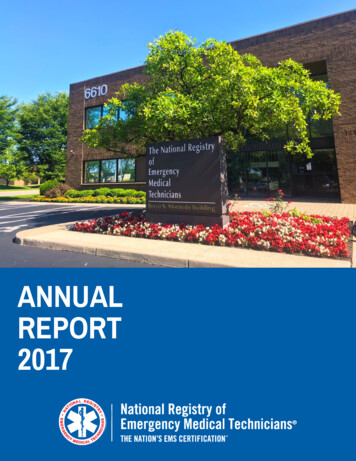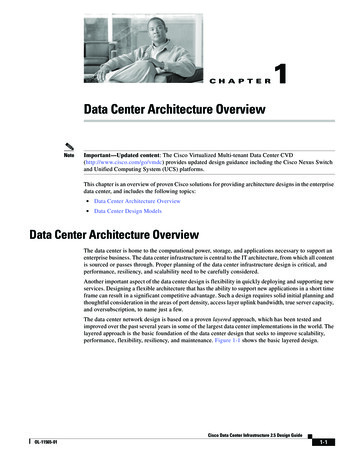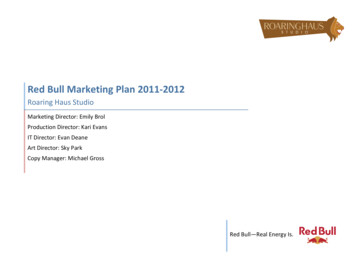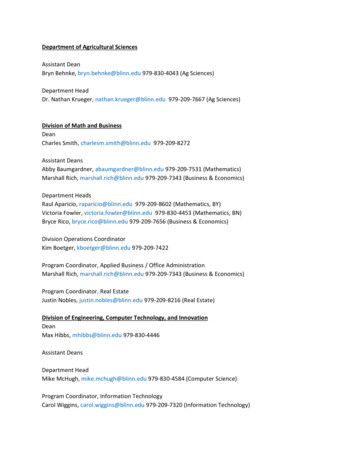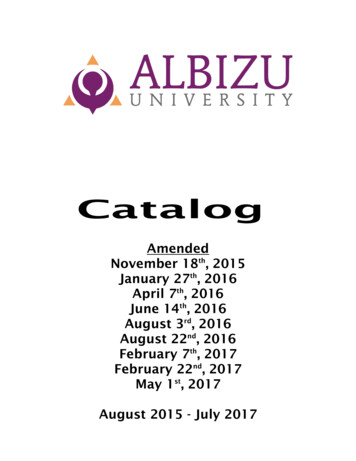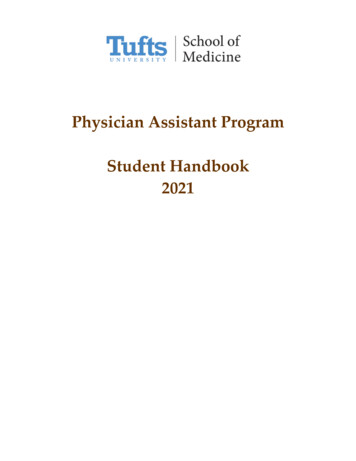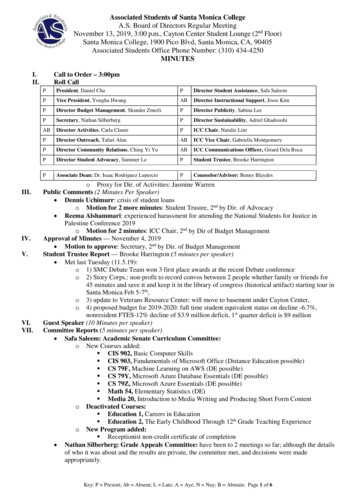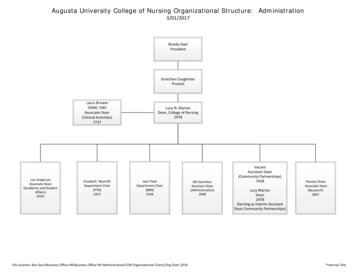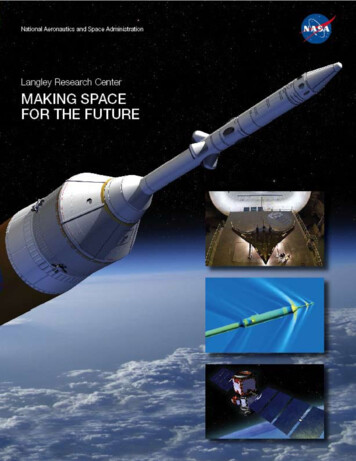
Transcription
CENTER DIRECTOR’S MESSAGEWelcome to NASA Langley Research Center in Hampton,Virginia.and hypersonic flight. Read the Aeronautics section for a more comprehensive review of this effort.I hope you’ll enjoy getting acquainted inthe following pages as we highlight our accomplishments as one of NASA’s 10 field centers.We’ve had an exciting time helping further the exploration of space, making new scientific discoveries about our home planet, and conducting breakthrough research in aeronautics to make air travelsafer and better for us all.What has made the past year so exciting atLangley?We have become an important part of the nation’squest to explore the solar system – NASA’s Visionfor Space Exploration to the moon, Mars, and beyond. Langley is helping to develop a space shuttlereplacement system, which includes two launchvehicles and the crew capsule known as Orion. Aspart of this effort, we are evaluating designs for alaunch-abort system that will provide crew escapeif the vehicle malfunctions during liftoff. We’realso helping with designs of Orion’s heat shield andlanding system – and so much more as you’ll find inthe Exploration section of this update.In aeronautics, Langley is hard at work contributing to NASA initiatives to make air travel safer,quieter, and more efficient through a program thatincludes work in fundamental aeronautics, aviationsafety and airspace systems. An example of this isthe research being done toward next-generationaircraft – such as the blended wing body, a significantly more fuel efficient and environmentallyfriendly design than current airplanes. Langley alsocontinues to advance developments in supersonicIn science, NASA Langley has partneredwith researchers around the world tostudy Earth from space so we may advance understanding of our home planet. Our newest missionwas launched in April 2006: the Cloud-Aerosol Lidar and Infrared Pathfinder Satellite Observations(CALIPSO). This mission will help us learn moreabout clouds and airborne particles called aerosolsso that scientists may understand how they affectour air quality, weather, and climate. We’re alsostudying the atmospheres on other planets in thesolar system – such as Mars – so that we can safelyexplore those planets.As a key part of our research and development efforts, Langley has formed strategic relationshipswith organizations throughout the private and public sectors. These partnerships and collaborationsnot only help us achieve challenging missions, theyalso enable the commercialization and availability– to you – of NASA technologies and services. Thiscollaboration also contributes to the economy ofthe region and the nation, a subject touched on inthe Economic Impact section of this document.Letting you know about our work here at Langleyis part of our mission. This update illustrates howyour tax dollars are being put to use for the benefitof all.Lesa B. RoeDirectorNASA Langley Research CenterLANGLEY 2006
CONTENTS1234ExplorationPage 4-5Langley assumes critical roles in the space shuttle return to flight, development of NASA’s Constellation Program, and the Orion crew capsuleAeronauticsPage 6-7The Center supports NASA research inaviation safety, fundamental aeronautics andfuture airspace systems, including developmentof next-generation aircraftSciencePage 8-9Planetary-airplane research, atmosphericsciences studies and development of Earthsensing satellites mark several of Langley’sprimary accomplishmentsSystems AnalysisPage 10-11Langley’s systems analysis experts supportaeronautics, space exploration, science, andspace operations by providing critical insightfor informed decision-makingCOVER ART: Artist’s conception of Orion Crew ExplorationVehicle. INSETS: (Top) blended wing body testing, (Center)computer modeling of the CLV, (Bottom) CALIPSO satellite.LANGLEY 2006
CONTENTS5678PartnershipsPage 12-13Langley’s innovative partnerships and collaborations with the nation’s public and privatesectors promote widespread commercializationand availability of NASA technologiesPeople of LangleyPage 14-15A statistical snapshot of Langley’s most important resource: engineers, scientists, researchers,technicians, analysts, and administrative staffEconomic ReportPage 18-20With a 2006 budget of 747 million, Langleyis a major contributor to the local, state, andnational economies with an output that exceeds 2 billion annuallyEducation & OutreachPage 22-23Langley’s comprehensive program to inform,educate, and inspire many audiences, fromstudents and teachers to the general public —while preparing for a 400th birthday partyLANGLEY 2006
Image opposite page: Lockheed MartinAn Orion Crew Vehicle in lunar Orbit
E X P L O R AT I O NHumankind is reaching beyond the planetof its birth to the moon, Mars, and theouter reaches of the solar system – perhaps even to other star systems. NASA is leadingthe way in making the Vision for Space Exploration attainable.After the International Space Station is completedand the space shuttle retired in 2010, the Visioncalls for the advancement of American scientific,security, and economic interests through a robustspace-exploration program that will have humansreturn to the moon by 2020 and explore Marssometime thereafter. Explorers won’t have to travelsuch far distances alone, though: specialized robotswill help, as will advanced computer systems andnext-generation technologies.Sending humans to distant worlds requires a newgeneration of rockets and passenger spacecraft.NASA’s Constellation Program is already developing the next generation of such craft. The Ares Iand Ares V launch vehicles will provide the thrust,while the Orion crew capsule will be a home inspace for astronauts.Orion’s launch-abort system to provide crew escape should a malfunction occur.In collaboration with NASA Ames ResearchCenter in California, Langley is developing theOrion heat shield. The shield will be attached tothe cone-shaped Orion to protect astronauts fromtemperatures that could exceed 4,800 degrees.Langley is also leading the development of optionsfor Orion’s landing system, and applying designand fabrication expertise toOrion pad-abort and ascentand-abort flight tests.n Shuttle return to flightIn addition, Langley is pron Ares I test flight upperviding critical expertise to thestage studiesConstellation system integran Orion launch-aborttion groups, including teamssystemof engineering experts whoare defining program requiren Constellation systemments and integrating theintegrationsystems necessary to makethis next generation of spaceexploration vehicles a reality.Getting Ares off the GroundReturning the Shuttle to FlightIn 2006, the return-to-flight team at Langleycontinued to support the space shuttle program,providing critical tools, analysis, and expertise tominimize foam loss from the external tank andprovide real-time assessments of the spacecraft’sthermal protection systems. Langley contributions to return to flight include an impact-detection system for the leading edge of the shuttle’swings, methods to repair them in the event of lifethreatening damage, and a new infrared camerafor astronauts to use during space walks.Making Exploration a RealityA Langley team is playing a significant role in theOrion crew module, evaluating conceptual designs inthe Center’s wind tunnels at speeds in excess of 5,000mph. Langley is also overseeing the development ofLangley leads development of the Ares launch system prototype for its first flight test in April 2009,managing the integration of all flight hardware elements and delivering the integrated test vehicleto NASA Kennedy Space Center in Florida. TheLangley team is conducting wind tunnel assessments and analyses to define the aerodynamicsof the Ares I vehicle and to evaluate potential designs.The Center will conduct structural and thermalanalyses in the development of the Ares I upperstage, and will continue studies to determine alternative approaches for several components. Langley is also assisting NASA Marshall Space FlightCenter in Alabama with Ares I upper-stage structural and thermal studies, including tests to verifyengineering models.LANGLEY 2006
AERONAUTICSFly faster. Fly farther. Fly safer – and not juston Earth. At NASA, aeronautics researchand space exploration are inextricablylinked; one day, “planetary” aircraft could fly theskies of Mars, Venus, Jupiter, and other worlds.Future aircraft may operate at thousands of milesper hour. They will be made to withstand extremeheating yet boast quiet, energy-efficient enginesthat don’t pollute and can operate at altitudesmuch higher than today’s aircraft.NASA’s New Aeronauticsn Aviation Safetyn Fundamentalaeronauticsn Airspace systemsn Testing and analysisNASA is focusing its aeronautics research on three primaryareas: aviation safety, fundamental aeronautics and futureairspace systems.The Center is playing key rolesin NASA’s fundamental research in materials and structures, aerodynamics, hypersonic and supersonicflight, fixed-wing and rotary-wing subsonic flight,aviation safety, and transformational air-trafficmanagement technology.Together, these activities leverage NASA’s aeronautics core competencies and address the fundamental research needs of the Next GenerationAir Transportation System (NGATS) for the JointPlanning and Development Office (JPDO).Next-Generation InnovationsThe Center is working with Boeing and the AirForce to explore low-speed stability and controlcharacteristics of a next-generation aircraft concepts such as the blended wing body, or BWB. ABWB would be significantly more fuel efficientand environmentally friendly than today’s jets. A21-foot model of the BWB, designated the X-48B,was tested in Langley’s 30x60-Foot Tunnel in Apriland May 2006. The X-48B will be flight tested at NASA Dryden Flight Research Center in California in 2007.In 2006, at Langley’s 8-Foot High TemperatureTunnel, the Center teamed with Pratt & Whitney Rocketdyne and the Air Force to conduct thefirst testing of a closed-loop, fuel-cooled, variablegeometry hypersonic engine at speeds of Mach 5(roughly 3,200 mph).In 2006, the Airborne Subscale Transport AircraftResearch Testbed was developed and flown in support of NASA’s Aviation Safety Program. This remotely piloted, dynamically scaled aircraft enablesflight validation for high-risk, upset-flight maneuvers in response to damage or environmentalhazards, while providing a means of assessing thereliability of flight-control software to withstandand adapt to dangerous flight conditions.To test advanced concepts and methods for airborne self-separation and spacing to address distributed-architecture research questions posed bythe JPDO, Langley conducted air-traffic-management research in its Air Traffic Operations Lab inpartnership with NASA Ames Research Centerin California, Boeing, MITRE Corp. and UnitedParcel Service.Decoding TurbulenceResearchers are also preparing for a flight test fromNASA Wallops Flight Facility in Virginia to studya challenge faced during the Shuttle’s return-toflight in 2005. Researchers want to better understand boundary-layer transition: the point whereair flow over an aerodynamic surface changes fromlaminar (smooth) to turbulent.For those studies, a rocket launched from Wallopswill fly at Mach 7, or more than 5,300 miles perhour. On board instruments will record data onthe boundary-layer transition. Langley will provide programmatic and engineering support toperform the test and analyze the data.LANGLEY 2006
The blended-wing body model beingtested in the 30x60-Foot Tunnel.
An artist’s depiction of the CALIPSOsatellite launched in April 2006.10LANGLEY 2006
SCIENCETalk about the weather and you’re guaranteed a conversation. Do something aboutthe weather and you’ll probably win a Nobel Prize.At Langley, we seek to understand the measure ofweather averaged over time: otherwise known asclimate. We’re partnering with colleagues aroundthe world to study Earth from space to better understand how the climate system responds to natural and human-induced changes. And we’re working to improve our predictions of the interactionsof land, air, and water.The Center has a rich heritage of scientific researchthat can be traced to the beginnings of Langley’sremote-sensing studies in the 1950s and 60s. Inthe past two decades, we’ve amassed a huge amountof data gathered from Earth-observing satellitesand are applying it to learn more about our homeplanet. We’re also leading several projects that willgenerate new data from airborne and space-basedmeasurement techniques to support a variety of atmospheric science and applied science research.Missions to Earth and BeyondLangley’s newest satellite mission – Cloud-AerosolLidar and Infrared Pathfinder Satellite Observations, or CALIPSO – thundered skyward atop aBoeing Delta II rocket in April 2006. CALIPSOwill enable scientists to study how clouds and aerosols form, evolve, interact, and affect Earth’s airquality, weather, and climate. In June, CALIPSOcollected its first data using lidar, an innovativelaser-based, remote-sensing technique. Data segments are streamed together to paint a picture ofwhat a vertical slice of our atmosphere looks like.CALIPSO is a collaboration between NASA andFrance’s Centre National d’Etudes Spatiales.We have also had the opportunity to contributeto a number of planetary science research projects.Our latest such proposal is known as ARES, orthe Aerial Regional-scale Environmental Survey ofMars. If selected, ARES would fly a science payload on the first aircraft to soar over another planet. Our researchers are actively involved in otherMars-related proposals, including an instrumentcalled Martian Atmosphere and Dust in the Optical and Radio (MATADOR) and several entry,descent, and landing activities.Sifting Climate CluesThis year, NASA’s Clouds andn Climate impacts ofthe Earth’s Radiant Energyaerosols and cloudsSystem, or CERES, continn A potential aircraftued to break new ground insurvey of Marsdata accuracy essential to clin Clouds and the Earth’smate research. The CERESRadiant Energy Systemteam has developed new waysn Tracking air-pollutionto integrate multiple instruflowsments on multiple satellitesto uncover key relationshipsin the climate system. CERES currently collects measurements from fourinstruments, playing a leading international rolein studying global climate change from space.In February 2006, our researchers were integrallyinvolved in writing and releasing the Assessmentof Stratospheric Aerosol Properties report, themost thorough assessment of how small particles interact in our upper atmosphere and affectEarth’s climate system.In March, Langley scientists participated in thefirst phase of one of the most complex field campaigns ever undertaken in the study of Earth’satmospheric chemistry. The IntercontinentalChemical Transport Experiment investigated airpollution flows from Mexico City and Asia, bringing together data from research satellites, aircraft,and ground-based instruments to track the pollution plumes and their potential effects on climateand human health.LANGLEY 200611
S Y S T E M S A N A LY S I SBold ventures require bold preparation. Themore complicated a project or program,the greater the need to explore multipleoptions in order to achieve the desired missionobjective.At Langley, our systems engineers and analysts arehelping NASA prepare to return to the moon, explore Mars and conduct missions throughout thesolar system. Our experts in systems analysis support aeronautics, space exploration, science, and space opn Space explorationerations, in providing criticalarchitecturesinsight for informed decisionn Lunar-surfacemaking to achieve missionapproachesobjectives.n Study of the airspaceWhat are the possible aptransportation systemproaches to meet certainn Impact of very light jetsmission goals and objectives?on the airspaceWhat systems and technologies are required to enablethese approaches and what arethe associated costs and risks? How much shouldwe spend on developing new systems and technologies? Questions like these go to the heart ofLangley’s systems-analysis process.Exploring Moon, Mars, and BeyondLangley’s systems analysts helped to define NASA’sVision for Space Exploration. We also made significant contributions to the Administrator’s 60-DayExploration Systems Architecture Study, leadingthe technology assessment and prioritization thatdefined such systems as the Crew Exploration Vehicle — Orion — and the crew and cargo launchvehicles, Ares I and V.We are currently playing a leadership role in NASA’sLunar Architecture Study to define lunar-surfaceaccess approaches, associated systems, and the ex-12ploratory science that will be done on the moon.We fully anticipate our involvement in similar activities for exploration of Mars and beyond.Our engineers have also participated in and provided analytical assessment for a congressionallymandated study to detect, characterize, and document near-Earth objects like asteroids and meteorites that could pose a global threat.Planning for 21st Century Air TravelLangley helped commercial aviation become a reality. In this new millennium, we’re helping thenation prepare for a dramatic expansion of jet travel. By 2020, air traffic may grow to three times thelevel of the year 2000.More people, more aircraft, more flights: that’s asnapshot description of what we’re modeling forother government agencies like the Federal Aviation Administration.One of our major accomplishments in 2006 wasan assessment of the impact of very light jets onthe nation’s airspace. These aircraft are expectedto greatly increase in numbers with flights frommedium and small airports not otherwise servedby commercial airlines. We also conducted anairspace transportation system vulnerability studyunder our Aviation Safety Program.Our Ultimate CustomerOur ultimate customer is the American citizen.By providing reliable analytical information inadvance of complex, multiyear programs andprojects, we help decision makers appropriatelyinvest taxpayer money. And we also help our colleagues develop and design robust aircraft, spacecraft, and the advanced technologies necessary forsafest possible air travel and the continued exploration of space.LANGLEY 2006
Horizontal lunar lander concept shownundocking from the Orion Crew Vehicle.
Our strategic partners participate in studies at Langley’s Transonic Dynamics Tunnel.Langley licenses a low temperature oxidation catalyst.A National Institute of Aerospace student working in theMorpheus Lab.14NASA technology used in aNASCAR Air Purifying System.LANGLEY 2006
PA RT N E R S H I P SFostering new invention. Transferring innovation from the laboratory to the marketplace.Advancing the nation’s competitiveness. Improving the day-to-day lives of American citizens.Educating current and future workforce.cies in ways that enhance agility and adaptabilityof the contributions to the agency mission. In certain cases, these relationships leverage cost sharingand other resources. Strategic relationships includepartners, suppliers, and customers.The Vision for Space Exploration reiterates the direction provided in the National Aeronautics andSpace Act of 1958 to promote innovative partnerships and commercial collaborations to help accomplish NASA’s challenging mission. NASA will continue to utilize and expand the use of partnershipsto make available a wider variety of technologiesand expertise than is available within the agency.Langley has established relationships with the National Institute for Aerospace (NIA), and the Research Operations, Maintenance, and Engineering (ROME) master contract. Langley maintainsrelationships with other government agencies anddepartments as well, includingArmy Research Labs, the AirForce Research Laboratory, then 1243 patents to dateNaval Air Systems Command,n Novel technologiesand the Department of Enern Applied problem-solvinggy’s Sandia National Laboratories. Langley seeks a balancedn Workforce educatorsamount of work for its customers in support of the nation’stechnological competitiveness.These partnerships also make NASA-developedtechnologies and services available for commercialization to stimulate economic development thatcan further benefit NASA and the public.Technology TransferTwo of the tools used by NASA for promoting private sector participation are the Small Business Innovation Research and Small Business TechnologyTransfer programs. These initiatives accelerate theinvolvement of small, high-tech companies by providing funding for research and development.The creation and transfer of innovation is a keygoal of technology transfer at Langley. In the pastnine years, the Center has averaged more than 150inventions per year, resulting in 22 U.S. patentsand 12 foreign patents annually. These inventionsspan a broad spectrum of aerospace technologies,including sensor and instrumentation, materials,aircraft innovations, and software.Langley has led NASA by averaging eight commercialization licenses per year that return approximately 550,000 in royalties. These licenses haveled to products that NASA has utilized on criticalspace, exploration and aeronautical programs.Strategic PartnershipsLangley implements the Agency’s strategy throughstrategic relationships. These relationships extendthe scope and application of Langley’s competen-Work with OthersDuring 2006, Langley scientists and engineerscompleted more than 100 projects working with,partners in other government agencies and industry. The projects spanned NASA’s mission areas ofspace exploration, the emerging commercial spacesector, space operations, science, and aeronauticsapplications for the civil defense and security sectors.Langley has partnered with the Defense AdvancedResearch Projects Agency and the Air Force, forexample, to investigate novel high temperaturematerials and hypersonic configurations for theForce Application and Launch from ContinentalUnited States (FALCON) program. And whenNASA Kennedy Space Center and Boeing experienced anomalies in nozzle-gimbal controls onthe rocket motors of the Delta II Heavy LaunchVehicle, Langley partnered with Boeing to applyCenter expertise in computational methods, flightdynamics, controls, and experimental testing inLangley’s internationally acclaimed National Transonic Facility.LANGLEY 200615
THE PEOPLE OF LANGLEYPeople are NASA Langley Research Center’smost important resource. The collectivecontributions from Langley engineers,scientists, researchers, technicians, analysts, andadministrative support staff are all essential toachieving mission success.Although the majority of Langley’s current workforce is permanent, the Center is beginning toemphasize the use of term andtemporary appointments to inn Term and temporarycrease staffing flexibility. Theseappointmentstime-limited appointments aren 72% are collegewell-suited to projects of a fixededucatedduration, enabling Langley ton More than 40% holdadjust skills to meet changingmaster or doctoralmission requirements.degreesWith an active role in NASA’sn The average length ofVision for Space Explorationservice is 20 yearsand continuing efforts in aeronautics, systems engineering,Earth science research, and systems analysis, thefuture of Langley employment is promising.By the Numbersgineering positions include aerospace engineers,computer engineers, electronics engineers, physicalscientists, physicists, and mathematicians.Professional administrative fields include humanresources, finance, procurement, information technology, and legal. Engineering technicians andelectronics technicians account for the majority oftechnician positions, although Langley also has anumber of quality-assurance specialists and equipment specialists. Clerical positions include secretaries and assistants.Dedication and MotivationStriving to hire “the best of the best” continuedat Langley in 2006, when 48 percent of new hiresheld bachelor degrees and 44 percent held masteror doctoral degrees. The Center recruits from anarray of public- and private-sector entities, including colleges and universities, the National Institutefor Aerospace, industry, business, and Langley’s cooperative-education program.Langley’s civil service workforce has an average of20.4 years of federal service: the second highestwithin NASA. Personal dedication to NASA’s mission and love of the work being performed appearto be key reasons for the continued service.NASA is recognized as a world-class science andengineering agency within the federal government. For its part, Langley is proud to employhighly technical, highly educated personnel, with In the recent Office of Personnel Management57 percent of the Center’s civil service employees Federal Human Capital Survey, 81.5 percent ofLangley employees “strongly agreed” or “agreed”engaged in engineering, research, andthat they liked the kind of work theyscientific fields. Currently, 72 perwere performing, and 72.6 percentcent of the Langley’s workforceOccupation Distributionhas at least a bachelor degree“strongly agreed” or “agreed” thatClericaland almost 20 percent hold atheir work gave them a feeling4%doctoral degree.of personal accomplishment.TechnicianMaintaining this high-caliber,Science &While there are four broad19 %motivated workforce is essenEngineeringcategories of occupations at57 %tial for Langley as it plays an acthe Center, they encompassAdministrativetiverole in NASA’s exploration,a variety of positions and ar20 %aeronautics, and science researcheas of expertise. For example,professional science and enand development.16LANGLEY 2006
Karen Taminger analyzes an aluminum fractured surface using an electronic scanning microscope.Jeffrey Hinkley, left, and Matthew Boyd work on an experimentinvolving active materials.LANGLEY 2006William Kinard with a model of the MISSE experiment that flew on the space shuttle.17
ECONOMIC REPORTThe Center contributes significantly to the local,state, and national economies. Langley’s budget infiscal year 2006 was 747 million, which reflectsan increase from the 2005 fiscal year of 19 million. In addition, the Centerhad 198 active reimbursablen Average budgetagreements for work funded by 780 million/yearothers in fiscal year 2006, acn Diversified portfoliocounting for an added 48 million – an increase of 41 percentn Impact on Hamptonover the previous year’s level.Roads, Virginiaand nationTo fulfill our responsibilitiesand achieve our goals, the Center requires a wide range of commodities and expertise that include engineering services, wind tunnel support and maintenance, laboratory testing,computer equipment, and the like. Langley utilizes innovative and efficient procurement mechanisms to fulfill this ongoing need for services andgoods.As Langley acquires goods and services to performthe NASA mission, the direct, indirect, and induced impacts of expenditures affect the economichealth and development of the local, state, andnational economies. The dollars spent by Langleyenhance business development, create jobs, and increase the tax base.Langley Funding Level 864m 864m 827m 827m800 751m 747m800 751m 728m 747m 728m 900 900D O L L A R SI NM I L L I O N SD O L L A R SI NM I L L I O N SSince our founding in 1917, Langley has continued to pioneer new frontiers in aeronautics and space research. The Center’s contributions to aerosciences, atmospheric sciences, andtechnology commercialization are improving theway the world 2002 20032004200520062002 2003200420052006Includes Langley programsIncludes Langley programsfunded from other NASAfunded from other undingFY 2006 Research & Development FundingExternal BusinessExternal Business 45 m 45 mCross AgencyCross AgencyProgramsPrograms 47 m 47 mInstitutionalInstitutionalSupportSupport 103 m 103 mSpace OperationsSpace Operations 17 m 17 mAeronauticsAeronautics 293 m 293 mScienceScience 105 m 105 mExplorationExploration 137 m 137 m20LANGLEY 2006
ECONOMIC REPORTEconomic ImpactIn fiscal year 2006, NASA Langley and its related organizations generated a total economic output for thenation of approximately 2,265 million, and created20,649 full time equivalent (FTE) jobs for researchprofessionals, scientists, engineers, and support services.The direct economic benefits flow from three primarysources that together create the majority of the directeconomic output. Three sources are direct procurements and expenditures, contractor services, and visitors to Langley.Direct procurement expenditures at Langley’s Hampton location for labor, operating equipment, supplies,and construction by the Center and related organizations totaled 722.0 million in FY 2006. Spendingby Langley visitors added another 5.4 million, yielding total direct expenditures in the Hampton Roadsregion of 727.5 million. Indirect expenditures added 378 million, and induced expenditures totaled 1,160 million.Taken as a whole, Langley facilities represent an investment in land, buildings and scientific equipment amounting to 2.6 billion that include 788acres. As Langley prepares for new missions andprograms, increasing infrastructure investment, evengreater regional economic benefits are likely to ensue.With a 2006 budget of 747 million, NASA Langleycreates a total economic output for the nation worth 2.3 billion and 20,649 jobs.Non-Monetary BenefitsLangley supports the welfare of the region, the Commonwealth of Virginia and the nation in other waysthat are not easily monetized, enriching quality of lifeand the well-being of the community at large.NASA Langley scientists and engineers have conceivedof and helped to put into practice many new scientificbreakthroughs. Not only has the direct expenditureon this work benefited the region and nation, it alsohas spawned numerous commercial activities, manyin Virginia. In Fis
and environmentally friendly than today’s jets. A 21-foot model of the BWB, designated the X-48B, was tested in Langley’s 30x60-Foot Tunnel in April and May 2006. The X-48B will be flight tested at NASA Dryden Flight Research Center in Califor-nia in 2007. In 2006, at Langley’s 8-Foot
